You thought Carnival was over with the sprinkling of the ashes on penitential hairdos? Not quite.
Carnival doesn’t slink away under cover of darkness when the marangon, the basso profundo bell in the campanile of San Marco, tolls midnight on Martedi Grasso. Two things have to happen for it to really be over — in my opinion, that is. Two things which are more predictable than the swallows returning to Capistrano.
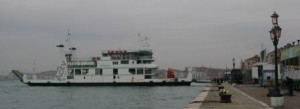
The first is the pulling apart and hauling away of the traveling amusement park (what they generically call a “Luna Park” here) which has been gracing the Riva dei Sette Martiri since — I believe — early December.
These people (as in much of the world) are almost exclusively families which have dedicated many generations to the setting up, operating, pulling down, and rolling on to the next location of their ride or concession stand.
After three months, I’m going to miss the smell of the hot-doughnut-frying-oil and the screeching of the children. It was fun strolling along the waterfront late every afternoon to mingle and kibitz. And I am convinced that as long as there is at least one small child walking home carrying a small plastic bag containing water and a goldfish, the world will not come to an end.

Anyway, the men start work early on Ash Wednesday morning, and by Thursday morning the funfair is gone. The only sign they’ve ever been here are the patches of new cement filling the holes in the pavement where their big rigs (or something) went astray.
Speaking of itinerant carnies, I went to the small town of Bergantino a few years ago when I was working on a story about the Po River (National Geographic, May, 2002). This former farming town has, since the Twenties and much more since the Sixties, become dedicated to the design, construction, and (eventually) operation of carnival rides — merry-go-rounds, bumper cars, etc. Despite the town’s modest size — it’s really just a village of some 2,000 people, when they’re all there, I mean, and not out on the road — they’ve carved away a heavy slice of this international industry for Italy. One of the major markets for their inventions is the USA.
Well, wherever they’ve gone, I’m already missing them.
The second element of the end of Carnival is the orgy of articles, editorials, and letters in the Gazzettino reviewing, celebrating, and vilifying the festivities just concluded. I can tell you without even having opened the paper that there will have been too many people for this fragile city to support; that the managing of this predictable overload will have shown inexcusable organizational flaws and failures to resolve the most elementary large-event necessities (toilets, in a word); that the money taken in doesn’t justify the stress and expense to the city; that it will have lacked originality and creative genius, and that for the residents and shopkeepers of Campo Santa Margherita, the ten days just concluded have been nothing less than at least six of the nine rings of hell.
And every year, the apex of all the claims and counter-claims: That this event would be (or ought to have been, or next year definitely will be) the “Carnival of the Venetians.” I saw Venetians having a fine time carnivalizing in their own modest way in various neighborhoods of the city, but not in the Piazza San Marco. I’d have given you a cash prize if you’d found any Venetians besides Lino in the Piazza San Marco.
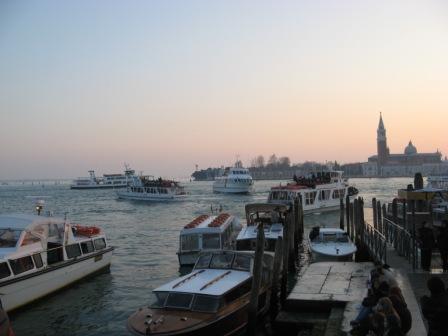
So when this wish to involve Venetians is mentioned, as if it were obviously a good thing, I ask myself if the speaker believes that a “Carnival of the Venetians” would have the slightest probability of pouring the millions of euros into the municipal strongboxes that all those tourists do. After all, Venetians don’t spend money on hotel rooms, restaurant meals, fancy masks, or whatever else makes Carnival matter. So frankly, what would be the point of spending money to organize a ten-day carnival for the few remaining locals? Just wondering.
Let’s go to the videotape (so to speak). Here is a smattering of the Gazzettino’s overview of Carnival 2010, as published yesterday:
The organizers claim that 150,000 people came the first Sunday; 250,000 the second Sunday (let that sink in…) and 40,000 on Martedi Grasso. Altogether, they say a total of 800,000 people came to Venice during Carnival. Perhaps not much compared to Rio, but for a city that covers a mere three square miles, not bad.
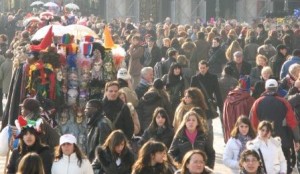
One new comment is by the businesspeople (especiallythose of restaurants and cafes) in the Piazza San Marco — they don’t want a maxi-stage there anymore. I’m not sure why, but I imagine it’s because it takes up too much space which needs to be available for them to put out their tables and chairs.
I could go on, but it’s probably not that interesting. These few days following Carnival are mainly spent in a sort of emotional and mental scrubbing and disinfecting.
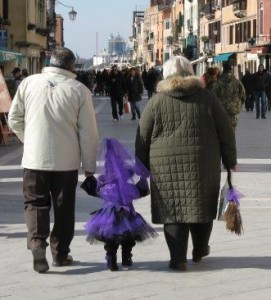
The summary is fairly concise. Apart from numbers, claims, and counter-claims as to success or failure, as one reporter wrote, “Now the Venetians can give a deep sigh of relief and put their hands on their foreheads and say, “‘Once again we’ve lived through it.'”



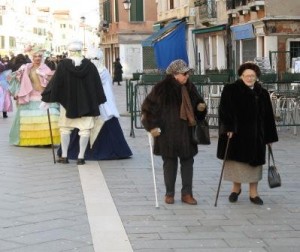
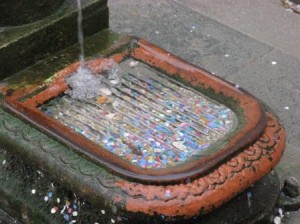

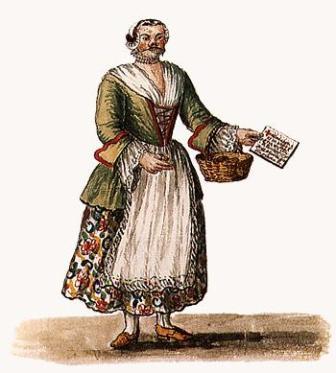
 The white mask often called a bauta is more correctly termed “Volto“ (face) or “Larva.” Sounds repellent, but it comes from the Latin meaning ghost, specter, minor evil spirit. Its extraordinary shape resolves several important concerns: First, it completely hides the face; second, it leaves space for the wearer to eat and drink; third, its shape alters the speaker’s voice, thereby acting as a kind of vocal, as well as visual, disguise.
The white mask often called a bauta is more correctly termed “Volto“ (face) or “Larva.” Sounds repellent, but it comes from the Latin meaning ghost, specter, minor evil spirit. Its extraordinary shape resolves several important concerns: First, it completely hides the face; second, it leaves space for the wearer to eat and drink; third, its shape alters the speaker’s voice, thereby acting as a kind of vocal, as well as visual, disguise.  I think my favorite is the “Moretta,” or “Servetta Muta.” It’s so strange it could only have come from France (it did), and it started out, at least, as something to be worn by women when they went to visit a convent. It was usually made of black velvet, and wasn’t attached by ribbons; you kept it on your face by biting down on a small button attached to the faceward side. (Hence the term “mute.”)
I think my favorite is the “Moretta,” or “Servetta Muta.” It’s so strange it could only have come from France (it did), and it started out, at least, as something to be worn by women when they went to visit a convent. It was usually made of black velvet, and wasn’t attached by ribbons; you kept it on your face by biting down on a small button attached to the faceward side. (Hence the term “mute.”) 
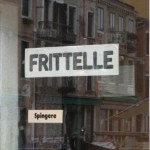
 Take that little business of Ulrich of Treffen, Patriarch of Aquileia. No need to lose ourselves in the maze that was Venice’s relationship with ecclesiastical power; let’s just say that for centuries religious disagreements were more commonly (and certainly clearly) expressed in political and military terms. Or, conversely, political and military projects almost always involved some highly placed representatives of the Prince of Peace.
Take that little business of Ulrich of Treffen, Patriarch of Aquileia. No need to lose ourselves in the maze that was Venice’s relationship with ecclesiastical power; let’s just say that for centuries religious disagreements were more commonly (and certainly clearly) expressed in political and military terms. Or, conversely, political and military projects almost always involved some highly placed representatives of the Prince of Peace. Thus every Giovedi Grasso, to recall this glorious victory/humiliation, the public festivities involved the slaughter of the bull (the patriarch) and the fat pigs (the canons). Nice! I’m not referring to the aspect of blood, I’m referring to the aspect of insult. And everybody enjoyed it so much that it continued even after the 200 years were up.
Thus every Giovedi Grasso, to recall this glorious victory/humiliation, the public festivities involved the slaughter of the bull (the patriarch) and the fat pigs (the canons). Nice! I’m not referring to the aspect of blood, I’m referring to the aspect of insult. And everybody enjoyed it so much that it continued even after the 200 years were up.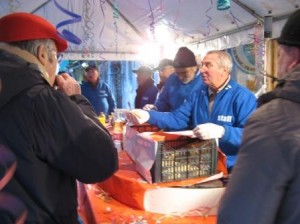 Me, bludgeonless, I went to the Societa’ di Mutuo Soccorso dei Calafati e Carpentieri for their fritola-fest this afternoon. This mutual-aid society, formed by the erstwhile Caulkers and Carpenters of the Arsenal, makes a specialty of sometimes organizing little neighborhood parties, almost exclusively intended for the kids. Although — from what I’ve seen — each kid seems to arrive accompanied by a phalanx of voracious relatives, none of whom appears starved for fat or sugar, and with the phrase “Me First” invisibly tattooed on their foreheads.
Me, bludgeonless, I went to the Societa’ di Mutuo Soccorso dei Calafati e Carpentieri for their fritola-fest this afternoon. This mutual-aid society, formed by the erstwhile Caulkers and Carpenters of the Arsenal, makes a specialty of sometimes organizing little neighborhood parties, almost exclusively intended for the kids. Although — from what I’ve seen — each kid seems to arrive accompanied by a phalanx of voracious relatives, none of whom appears starved for fat or sugar, and with the phrase “Me First” invisibly tattooed on their foreheads.  It was a wonderful little interlude, out in via Garibaldi. The fritole were the best I’ve ever had, delectable little blobs, not too big, containing just the right amount of candied fruit and covered with a little more than the right amount of sugar. The galani were heavenly, shards of deep-fried dough thinner than onionskin, under clouds of powdered sugar. If there’d been more of a crowd I’d certainly have gone back for thirds, and fourths, and fifths. But I didn’t want the guys to start thinking, What — her again?
It was a wonderful little interlude, out in via Garibaldi. The fritole were the best I’ve ever had, delectable little blobs, not too big, containing just the right amount of candied fruit and covered with a little more than the right amount of sugar. The galani were heavenly, shards of deep-fried dough thinner than onionskin, under clouds of powdered sugar. If there’d been more of a crowd I’d certainly have gone back for thirds, and fourths, and fifths. But I didn’t want the guys to start thinking, What — her again?
